Nemertea
Ribbon Worms
Jon L. Norenburg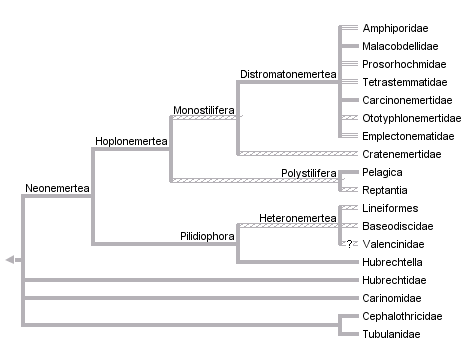


This tree diagram shows the relationships between several groups of organisms.
The root of the current tree connects the organisms featured in this tree to their containing group and the rest of the Tree of Life. The basal branching point in the tree represents the ancestor of the other groups in the tree. This ancestor diversified over time into several descendent subgroups, which are represented as internal nodes and terminal taxa to the right.

You can click on the root to travel down the Tree of Life all the way to the root of all Life, and you can click on the names of descendent subgroups to travel up the Tree of Life all the way to individual species.
For more information on ToL tree formatting, please see Interpreting the Tree or Classification. To learn more about phylogenetic trees, please visit our Phylogenetic Biology pages.
close boxReferences
Envall, M. 1998. General problems in estimating nemertean relationships on ribosomal sequence data - an example using six monostiliferous species and mitochondrial 16S rDNA. Hydrobiologia 365:19-31.
Gibson, R. 1994. Nemerteans. Synopses of the British Fauna [New Series] No. 24, 2nd edition. Field Studies Council, Shrewsbury, UK, 224 pp.
Gibson, R. 1995. Nemertean genera and species of the world. An annotated checklist of original names and description citations, synonyms, current taxonomic status, habitats and recorded zoogeographic distribution. Journal of Natural History 29:271-562.
Härlin, M. 1998. Tree-thinking and nemertean systematics, with a systematization of the Eureptantia. Hydrobiologia 365:33-46.
Maslakova, S. A. and J. L. Norenburg. 2001. Phylogenetic study of pelagic nemerteans (Pelagica, Polystilifera). Hydrobiologia 456:111-132.
Moore, J. and R. Gibson. 1985. The evolution and comparative physiology of terrestrial and freshwater nemerteans. Biological Reviews 60:257–312.
Roe, P. and J. L. Norenburg. 2001. Morphology and taxonomic distribution of a newly discovered feature, postero-lateral glands, in pelagic nemerteans. Hydrobiologia 456:133-144.
Schwartz, M. L. and J. L. Norenburg. 2001. Can we infer heteronemertean phylogeny from available morphological data? Hydrobiologia 456:165-174.
Stricker, S. A., T. L. Smythe, L. Miller, and J. L. Norenburg. 2001. Comparative biology of oogenesis in nemertean worms. Acta Zoologica 82(3):213-230.
Sundberg, P. and R. Hylbom. 1994. Phylogeny of the nemertean subclass Palaeonemertea (Anopla, Nemertea). Cladistics 10:347-402.
Sundberg, P. and M. Svensson. 1994. Homoplasy, character function, and nemertean systematics. Journal of Zoology 234:253-263.
Sundberg, P., J. M. Turbeville, and S. Lindh. 2001. Phylogenetic relationships among higher nemertean (Nemertea) taxa inferred from 18S rDNA sequences. Molecular Phylogenetics and Evolution 20:327-334.
Thollesson, M. and J. L. Norenburg. 2003. Ribbon worm relationships: a phylogeny of the phylum Nemertea. Journal of the Royal Society of London B 270:407-415.
Turbeville, J. M. 1991. Nemertea. Pages 285-328 in: Microscopic Anatomy of Invertebrates. F. W. Harrison and B. J. Bogitsch, eds. Wiley-Liss, New York.
Turbeville, J. M., K. G. Field, and R. A. Raff. 1992. Phylogenetic position of phylum Nemertini, inferred from 18s rRNA sequences: Molecular data as a test of morphological character homology. Molecular Biology and Evolution 9:235-249.
Information on the Internet
- Nemertes, your web resource for Nemertean research. Jon Norenburg and Frank Crandall.
- Introduction to the Nemertini. Tied up in knots. . .. UCMP Berkeley.
Title Illustrations

| Scientific Name | Baseodiscus delineatus |
|---|---|
| Location | Madeira |
| Specimen Condition | Live Specimen |
| Identified By | Ray Gibson |
| Copyright |
© Peter Wirtz

|
| Scientific Name | Drepanogigas albolineatus |
|---|---|
| Location | Madeira |
| Specimen Condition | Live Specimen |
| Identified By | Ray Gibson |
| Copyright |
© Peter Wirtz

|
About This Page
Jon L. Norenburg

Smithsonian National Museum of Natural History, Washington, D. C., USA
Correspondence regarding this page should be directed to Jon L. Norenburg at
Page copyright © 2004 Jon L. Norenburg
All Rights Reserved.
- First online 23 March 2004
- Content changed 16 April 2004
Citing this page:
Norenburg, Jon L. 2004. Nemertea. Ribbon Worms. Version 16 April 2004 (temporary). http://tolweb.org/Nemertea/2489/2004.04.16 in The Tree of Life Web Project, http://tolweb.org/




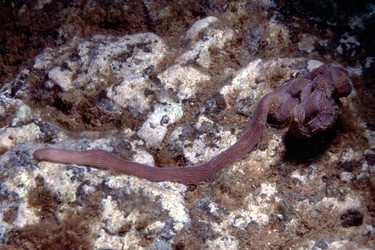
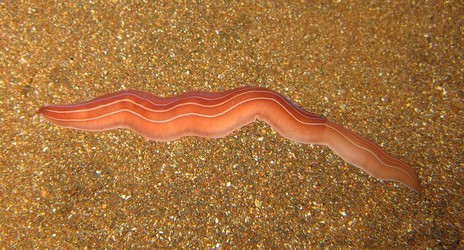
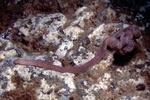
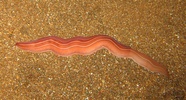

 Go to quick links
Go to quick search
Go to navigation for this section of the ToL site
Go to detailed links for the ToL site
Go to quick links
Go to quick search
Go to navigation for this section of the ToL site
Go to detailed links for the ToL site